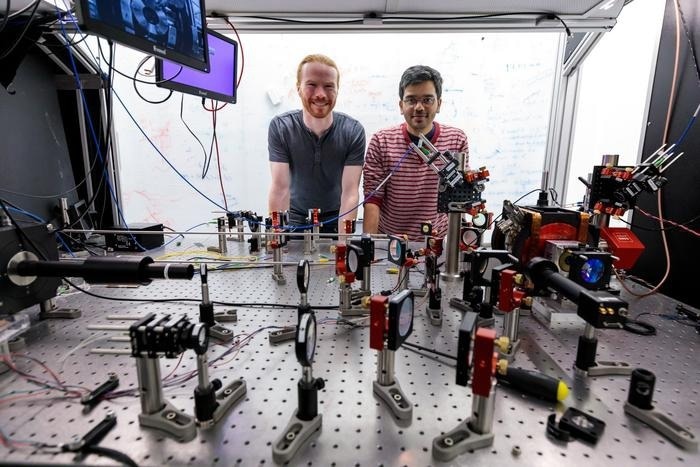Researchers from the Pritzker School of Molecular Engineering at the University of Chicago have developed a novel approach that combines photonic devices with trapped atom arrays. This advancement paves the way for innovative systems in quantum computing, networking, and simulation, allowing for the creation of large, scalable quantum systems. Their findings were published in the journal Nature Communications.

Researchers in Bernien Lab, including graduate students Noah Glachman (left) and Shankar Menon, have discovered how to combine two powerful technologies trapped atom arrays and photonic devices to yield advanced systems for quantum computing, simulation, and networking. Image Credit: John Zich
Quantum information systems offer more powerful and faster computing capabilities for tackling some of the world’s toughest problems compared to traditional computers. However, to fully harness this potential, scientists need to develop larger and more interconnected quantum computers. Achieving this involves overcoming significant challenges in connecting multiple quantum systems and scaling them up effectively.
We have merged two technologies which, in the past, have really not had much to do with each other. It is not only fundamentally interesting to see how we can scale quantum systems in this way, but it also has a lot of practical applications.
Hannes Bernien, Assistant Professor and Study Senior Author, Molecular Engineering, University of Chicago
Constructing quantum processors with arrays of neutral atoms trapped in optical tweezers and focused laser beams is becoming increasingly common. These arrays can hold atoms in place and enable complex quantum computations with thousands of qubits.
However, integrating photonic devices to collect data in the form of photons can easily disrupt these delicate quantum states, posing a challenge for maintaining the integrity of quantum information.
Connecting atom arrays to photonic devices had been quite challenging because of the fundamental differences in the technologies. Atom array technology relies on lasers for their generation and computation. As soon as you expose the system to a semiconductor or a photonic chip, the lasers get scattered, causing problems with the trapping of atoms, their detection, and the computation.
Shankar Menon, Study Co-First Author and Graduate Student, Pritzker School of Molecular Engineering, University of Chicago
Bernien's group recently tackled these challenges by developing a novel semi-open chip design that allows atom arrays to interact seamlessly with photonic circuits. This innovative platform supports quantum computations within a designated computation region. Once the computations are complete, a subset of atoms containing the necessary data is transferred to a connection region, where it integrates with the photonic chip.
We have two separate regions that the atoms can move between, one away from the photonic chip for computation and another near the photonic chip for interconnecting multiple atom arrays. The way this chip is designed, it has minimal interaction with the computational region of the atom array.
Noah Glachman, Study Co-First Author and Graduate Student, Pritzker School of Molecular Engineering, University of Chicago
The qubit interacts with a small photonic device in the connection region that extracts photons. These photons can then be transmitted via optical fibers to other systems. This setup suggests that connecting multiple atom arrays could enable the creation of a larger quantum computing platform than what a single array alone can achieve.
Additionally, the new method allows for multiple nanophotonic cavities to be coupled to a single atom array simultaneously, which could significantly enhance computational speed.
Menon said, “We can have hundreds of these cavities at once, and they can all be transmitting quantum information at the same time. This leads to a massive increase in the speed with which information can be shared between interconnected modules.”
Although the researchers have successfully demonstrated the ability to trap and move atoms across different regions, they plan to conduct follow-up investigations. These future studies will focus on additional stages of the process, including collecting photons from the nanophotonic cavities and exploring how to create entanglement over extended distances.
Journal Reference:
Menon, S. G., et al. (2024) An integrated atom array-nanophotonic chip platform with background-free imaging. Nature Communications. doi.org/10.1038/s41467-024-50355-4.